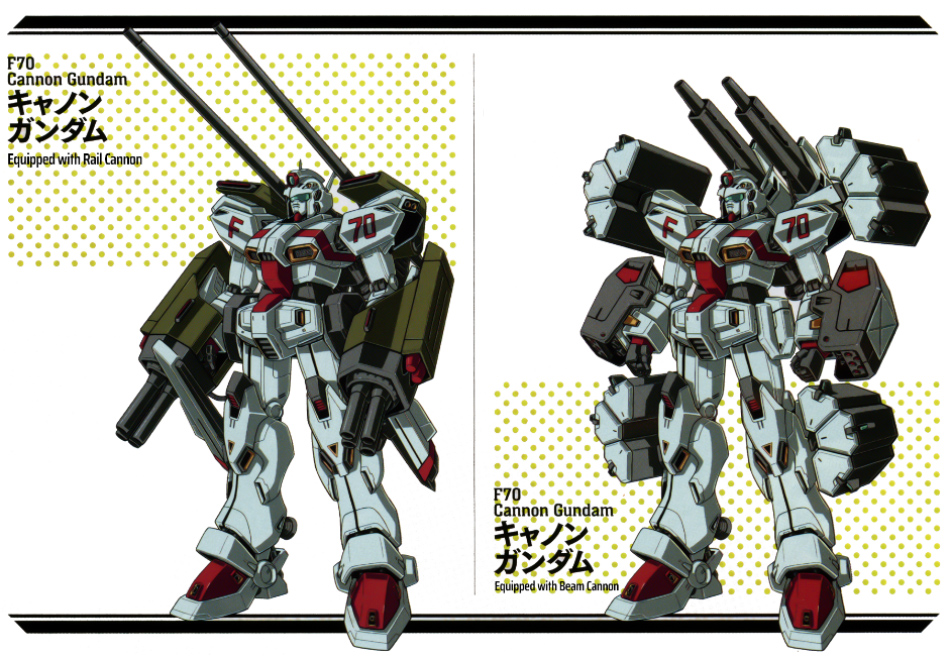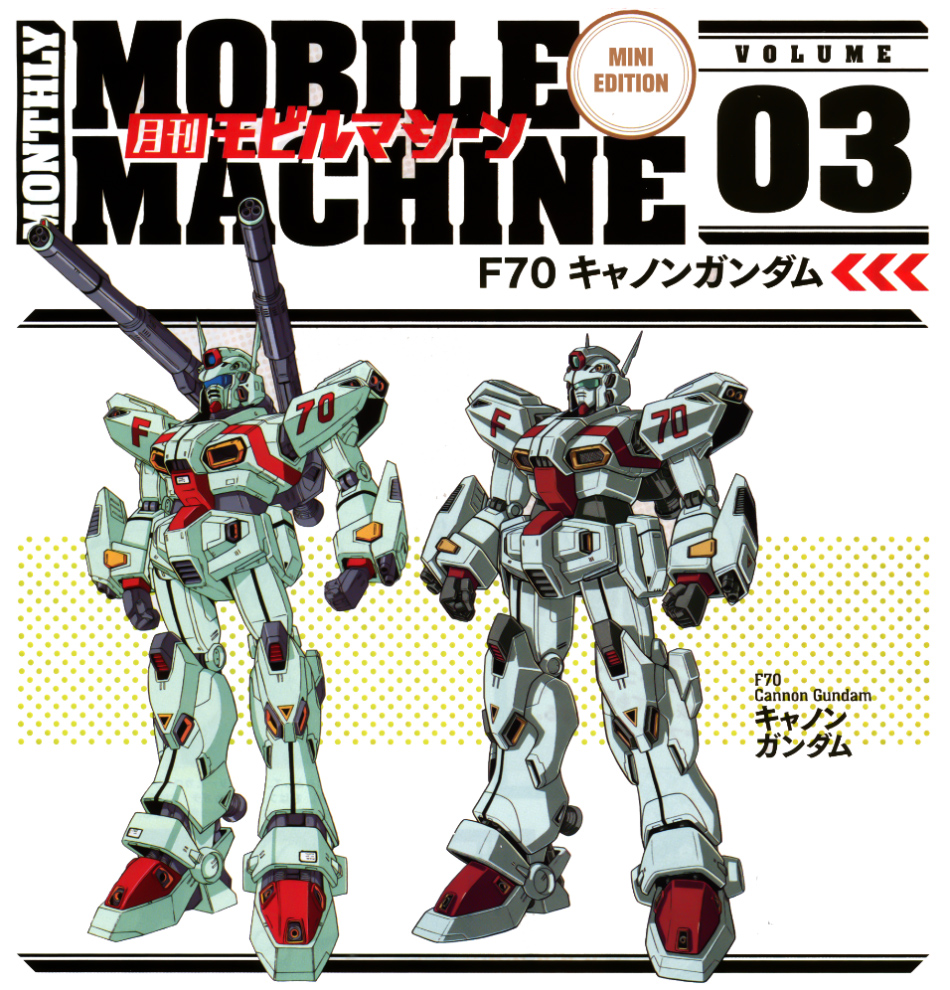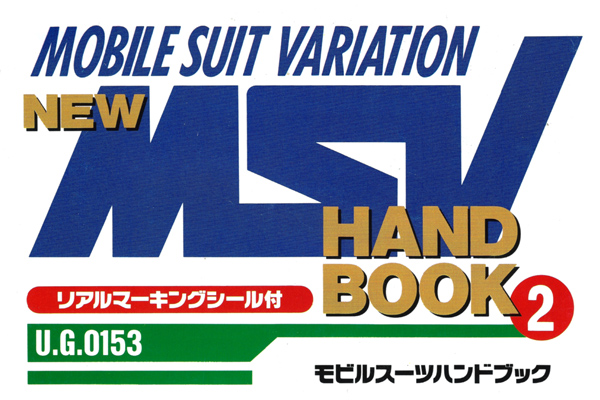MONTHLY MOBILE VOL.03
Model Number: F70
Overall Height: 14.8m
Full Weight: 22.5t (equipped with machine cannon)
Armaments:
double beam gun x 2
vulcan gun x 2
beam saber x 2
beam rifle
Selective Armaments:
beam cannon x 2
machine cannon x 2
150mm high-velocity rail cannon
others
SNRI’s GUNDAM
Universal Century 0102.
The Strategic Naval Research Institute (SNRI) proposed downsizing the ever-increasing size of mobile suits to an overall height of 15 meters while maintaining their functionality.
This increase in the size of mobile suits would demand the expansion of operating facilities, resulting in an inevitable skyrocketing parts budget and a rapid updating and retrofitting of ships and bases. Moreover, SNRI argued that newer models that would follow the RGM-89 Jegan and FD-03 Gustav Karl had to avoid this trend due to the declaration of the eradication of all conflict that followed the dissolution of the Republic of Zeon’s autonomy.
Following this proposal, several scaled-down mobile suit plans (including the later Guntank R44) were put forward, eventually producing Anaheim’s RGM-109 Heavygun.
However, SNRI denounced the Heavygun, citing a lack of innovation and that it was nothing more than a scaled-down version of the Jegan, and ultimately rejected Anaheim’s MSA-0120 proposal in favor of beginning work on the Formula project as a means to achieve their desired vision.
Behind this was influential support from so-called “arsenalists” of the Assembly and General Staff Headquarters, who feared that Anaheim would monopolize mobile suit development. Since the end of the Gryps War, the Federation Forces arsenals could no longer develop their own mobile suits, so Anaheim seized the initiative, having been a sponsor of the AEUG.

(Left) A heavy artillery version equipped with the F90’s S-Type loadout. Although the F71 did not adopt this, one theory suggests that the suit was redesigned as the Cosmo Babylonian war for independence intensified. (Right) A heavy bomber version based on the F90 B-Type, which was deemed an unnecessary loadout for low-intensity conflicts, was not adopted for the mass-produced F71.
However, maintenance of these arsenals was under the direct control of the military and was essential in the event of emergencies, more specifically, in the event the Federation Forces found themselves at odds with Anaheim. So the “arsenalists” insisted that mobile suit development technology be taken back from the Lunarians to a more Earth-Colony initiative, a widely shared sense of urgency that went beyond the scope of just being Earthnoid/Spacenoid. After all, it was a Federation arsenal that developed the RX-78.
X X X
Developed from the data obtained from the first phase F9 testing operation project conducted by Patsy Angelika and others came the F7 series Unit 0 mass production type. F7, in this case, stands for bombardment type. This is the F70 Cannon Gundam.
At the time, it was considered taboo within the military to use the name Gundam, which was seen as a symbol of resistance and the Newtype. For example, the RX-104FF was only referred to as the Penelope during operations, and the official code for the F90 did not include the designation Gundam.
However, it was evident that the SNRI technical team at the time, having given the designation Gundam to this mass-production version of the F90, demonstrated they had the grit to resist the era of days past.
In fact, the F70 was not just a mass-produced version of the F90. It had several upgrades, including an enhanced ballistic-resistant cockpit and composite thruster vanes on the back and legs that would lead to those on the F91. Hardpoints on the arms, waist, and legs were similar to those on the F90, and twin-engine leg generators, which despite their high output, were time-consuming to maintain, were moved to its back.
Furthermore, the fact that the F70 has the same fire control capabilities as the F90 without needing a pseudo-personality computer demonstrates the superiority of SNRI’s avionics. The F70’s back-mounted main gun can switch between a 3-barrel machine cannon, a 150mm high-speed rail cannon, or a beam cannon. In addition, the hardpoints on the arms, shoulders, sides of the waist, and legs were standardized with the F90. Among these, the hardpoints mounted on the arm were equipped with twin-barrel beam guns and a miniaturized version of the F90 S-Type’s 4-barrel beam cannon as standard equipment, though it could also specialize in fire support missions by equipping the S-Type unit. Similarly, mounting the B-type launcher allows it to be used as a heavy bomber mobile suit (as depicted in the CG concept art shown, which was created in U.C. 0115).
On top of that, the F70 was designed with the ability to adapt to close combat by purging its main gun unit. The overall propulsion from the thrusters was 113,300kg, significantly more than the F90’s 74,760kg. Along with the apogee motors located on various parts of its body, the F70 demonstrated exceptional performance in both dogfights and hit-and-run attacks. While it was not as versatile as the F90 (F80), it was a tour de force with consummate performance as a general-purpose mobile suit.
Despite that, the F70 was never mass-produced as SNRI had intended.
In our next article, we’ll discuss the circumstances behind this.
(U.C.0146.10.10 Dinah Kim)





